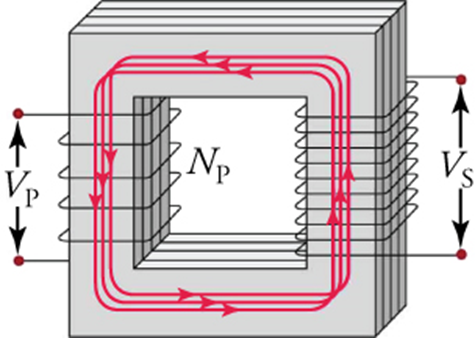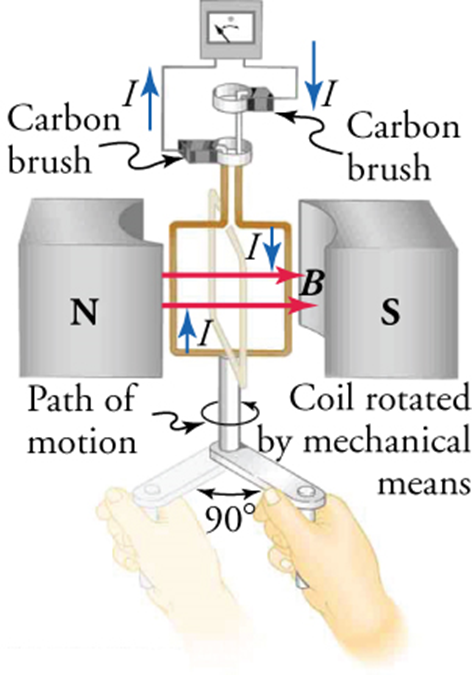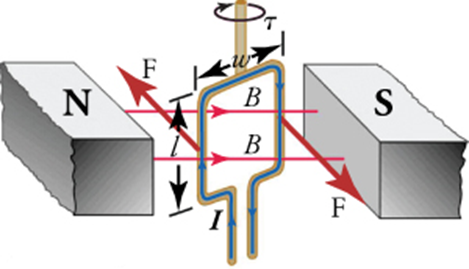Electricity and electronics: State, explain and apply principles used in electrodynamics
Unit 1: Generating electricity
Leigh Kleynhans
Unit outcomes
By the end of this unit you will be able to:
- Identify and differentiate between stationary and moving electrical machines (transformer, generator and motor).
- Describe the efficiency of stationary and moving electrical machines.
- Define single-phase and three-phase.
- Identify the applications of single- and three-phase electricity.
What you should know
Before you start this unit, make sure you can:
- Describe and apply electromagnetic induction to produce current by using a changing magnetic field. Refer to level 3 subject outcome 4.2 unit 2 if you need help with this.
- Describe how electromagnetic induction is applied in dynamos and transformers. Refer to level 3 subject outcome 4.2 unit 2 if you need help with this.
Introduction
An electrical machine transforms energy. This can be either electrical energy converted into mechanical energy which happens in a motor or the conversion of mechanical energy into electrical energy which happens in a generator. A transformer is also an electrical machine that converts voltage and current to different levels. You have already learnt how generators and transformers apply the principle of electromagnetic induction in their operation. In this unit we will classify electrical machines according to whether they involve moving parts or not, as well as introduce the principle of single- and three-phase electricity.
Types of electrical machines
Electrical machines are classified into two main types:
- stationary electrical machines
- dynamic (moving) electrical machines.
Stationary electrical machines
A stationary electrical machine is a machine which does not have any moving parts. The components remain stationary throughout its operation.
A transformer is an example of a stationary electrical machine. It is a machine because there is a conversion of energy between the windings (turns) of the transformer. Electrical energy is converted into magnetism in one coil of the transformer and then the magnetism is converted back into electrical energy in the other coil. The ratio of the number of turns in the primary coil to the number of turns in the secondary coil determines how this process increases or decreases the AC voltage and current levels.
The primary and secondary coils are both wound around a stationary iron core. There are no moving parts involved in the energy transformation. It is the varying AC current in the primary winding, which creates a varying magnetic flux in the iron core of the transformer. This varying magnetic flux induces an in the secondary winding of the transformer, resulting in an AC current at the output.

Many cell phones, laptops, video games, power tools, and small appliances have a transformer built into their plug-in unit that changes [latex]\scriptsize 120\text{ V}[/latex] or [latex]\scriptsize 240\text{ V}[/latex] into the voltage required by the device.
Dynamic (moving) electrical machines
Dynamic electrical machines consist of moving parts as well as stationary parts. There are two types of dynamic electrical machines: generators and motors .
Generators are electrical machines which convert mechanical energy into electrical energy. You have learnt about Faraday’s law, which states that a conductor placed inside a varying magnetic field will experience an induced emf. In other words, moving a conductor in a magnetic field will induce emf in the conductor and current electricity will be produced.

When the coil in the generator in figure 2 is rotated, the magnetic flux changes from a maximum to zero, inducing an emf, which drives a current through an external circuit. The moving part is the coil that is rotated inside the magnetic field. The source of mechanical energy that turns the coil can be falling water (hydropower), rising steam produced by the burning of fossil fuels, or the kinetic energy of wind. The resultant induced current (electrical energy) flows through the conductor.
A motor is a dynamic electrical machine which converts electrical energy into mechanical energy – the exact opposite of a generator. Electrical motors have a moving part called the rotor and a stationary part called the stator.
Electrical motors generate a mechanical force as a result of the interaction between a magnetic field and current in a conductor placed in the magnetic field. Motors consist of loops of wire (the rotor) in a magnetic field (the stator). When current is passed through the loops, the magnetic field exerts a torque on the loops, which rotates a shaft. Electrical energy is converted to mechanical energy in the process.

This effect can be seen in toy cars where the rotating shaft is connected to the wheels of the car and a battery supplies the current. Motors are also used in washing machines, tumble driers and fans to create the rotating movement in these appliances.
Exercise 1.1
- What happens in an electric motor?
- An electric motor transforms electrical energy into mechanical energy.
- An electric motor transforms mechanical energy into electrical energy.
- An electric motor transforms chemical energy into mechanical energy.
- An electric motor transforms mechanical energy into chemical energy.
- What happens in a transformer?
- A transformer transforms electrical energy into mechanical energy.
- A transformer transforms magnetism into electrical energy.
- A transformer transforms chemical energy into mechanical energy.
- A transformer transforms mechanical energy into chemical energy.
- What happens in a generator?
- A generator transforms electrical energy into mechanical energy.
- A generator transforms mechanical energy into electrical energy.
- A generator transforms chemical energy into mechanical energy.
- A generator transforms mechanical energy into chemical energy.
The full solutions are at the end of the unit.
Efficiency of electrical machines
Efficiency is a measurement of how well a machine carries out the transformation of energy from one kind into another. It is the ratio of the output energy to the input energy, expressed as a percentage.
[latex]\scriptsize \%Efficiency=\displaystyle \frac{{output\text{ }energy}}{{input\text{ }energy}}\text{ x 100}[/latex]
It is simply not possible to make a machine [latex]\scriptsize 100\%[/latex] efficient. There will always be some wasted energy. This means conversion into types of energy other than the type of energy required from the machine.
In dynamic electrical machines (motors and generators) the moving parts will experience friction resulting in some conversion of energy into heat. Friction results from surfaces rubbing together. Friction can be minimised by using or such as grease, oil, or fine powder. This will reduce the amount of wasted energy.
Efficiency in a dynamic electrical machine can also be reduced by what is referred to as windage. Windage results from the rotating parts driving air around a motor, inside or out. Fans inside a motor increase the windage but help to heat, so it has an advantage as well as a disadvantage.
In stationary electrical machines (transformers), there is no loss of energy as a result of friction because there are no moving parts. An ideal transformer would therefore be [latex]\scriptsize 100\%[/latex] efficient. However, in practice, energy is dissipated due to resistance in the wires of the windings and to magnetic effects in the core. Transformers are, in general, highly efficient, and large power transformers in the national grid may attain efficiencies as high as [latex]\scriptsize 99.75\%[/latex]. Small transformers such as those that power consumer electronics may be about [latex]\scriptsize 85\%[/latex] efficient. The small percentage of dissipated energy is in the form of heat. You may have experienced this when you touch a transformer after a device has been operating for some time, it will feel warm.
Regardless of which type of electric machine is chosen for a particular job, efficiency is important for several reasons. Firstly, and perhaps most obvious, a less efficient machine will cost more to operate. Secondly, the energy ‘losses’ in the machine are converted to heat, which raises the operating temperature of the machine. The life of insulation is strongly related to the operating temperature. Thus, the machine must be designed to tolerate the heat created.
Exercise 1.2
- How is efficiency of an electrical machine calculated?
- Complete the following table:
Type of electrical machine Primary type of output energy Type of wasted energy motor generator transformer
The full solutions are at the end of the unit.
Single and three-phase electricity supply
Single phase electricity supply refers to when there is one conducting wire in the AC current circuit. This is the kind of electricity supply from a generator as illustrated in figure 2 and the operation of which you have studied in a previous unit. As the coil is rotated through the magnetic field, an emf, and consequently a current, is induced. Because the change in the magnetic flux is not constant, the induced emf and current are not constant, but fluctuate at a regular frequency. This can be represented in a graph as illustrated in figure 4.

The disadvantage of single-phase electricity, as seen in the graph in figure 4, is that twice every cycle the voltage will be zero. This problem can be solved by using a generator with three coils, each at [latex]\scriptsize {{120}^{0}}[/latex] to each other and all rotating through the magnetic field.

As a result of this set-up, the electric current is carried in three separate conducting wires; P1, P2 and P3, referred to as three-phase. At no time will there be zero voltage, and the supply is relatively constant.

The graph shows the three separate wave forms for each conducting wire.
Residential homes are usually served by single-phase power supply, while commercial and industrial facilities usually use three-phase supply. The key difference between single-phase and three-phase is that three-phase better accommodates higher loads. Single-phase is sufficient for lighting and heating, however, three-phase would be required to run large electric motors. Three phase supply is also more efficient than single-phase. Single phase AC has the advantage that it only requires two wires.
Exercise 1.3
- Define single-phase electricity supply.
- Define three-phase electricity supply.
- Give an example of where single-phase and where three-phase electricity supply would be used.
The full solutions are at the end of the unit.
Summary
- A stationary electrical machine is a machine which does not have any moving parts. The components remain stationary throughout its operation. An example is a transformer.
- Dynamic electrical machines consist of moving parts as well as stationary parts. Examples are motors and generators.
- Efficiency is a measurement of how well a machine carries out the transformation of energy from one kind into another. It is calculated using the formula:
[latex]\scriptsize \%Efficiency=\displaystyle \frac{{output\text{ }energy}}{{input\text{ }energy}}\text{ x 100}[/latex] - No electrical machines will be [latex]\scriptsize 100\%[/latex] efficient because of the conversion of some electrical energy into heat energy during operation.
- Moving electrical machines will be less efficient than stationary electrical machines because of friction between moving parts.
- Single-phase electricity supply uses a single conducting wire, the voltage and current fluctuate and can be represented in a single wave form.
- Three-phase electricity supply uses three conducting wires to supply current in order to keep the current consistent. It is represented in a triple wave form.
- Single-phase electricity is used when the demand of the load is low and three-phase electricity is used in high demand situations.
Unit 1: Assessment
Suggested time to complete: 15 minutes
- What makes stationary electrical machines different from moving electrical machines?
- Why are transformers classified as stationary electrical machines?
- State three sources of mechanical energy used to rotate the moving parts of a generator.
- Name the component of a motor that:
- is stationary
- is moving.
- Why are electrical machines not [latex]\scriptsize 100\%[/latex] efficient?
- Why would it be important to know the efficiency of an electrical machine?
- Tabulate the features of single-phase and three-phase electricity supply under the following headings: operation, wave form, construction, efficiency, cost, and applications.
The full solutions are at the end of the unit.
Unit 1: Solutions
Exercise 1.1
- A
- B
- B
Exercise 1.2
- The ratio of the output energy to the input energy converted to a percentage; use the formula:
[latex]\scriptsize \%Efficiency=\displaystyle \frac{{output\text{ }energy}}{{input\text{ }energy}}\text{ x 100}[/latex] - .
Type of electrical machine Primary type of output energy Type of wasted energy motor kinetic/mechanical heat generator electrical heat transformer electrical heat
Exercise 1.3
- Single-phase electricity supply uses a single conducting wire, the voltage and current fluctuate and can be represented in a single wave form.
- Three-phase electricity supply uses three conducting wires to supply current in order to keep the current consistent. It is represented in a triple wave form.
- Single-phase: homes, shops, offices for heating and lighting
Three-phase: factories, industrial plants using heaving machinery
Unit 1: Assessment
- There are no moving parts in a stationary electrical machine, whereas a moving electrical machine has both moving and static parts.
- Transformers have no moving parts.
- falling water, rising steam, wind
- .
- stator
- rotor
- Not all the input energy is converted into output energy. Some energy is used to overcome friction in the moving parts and is transformed into heat.
- The efficiency gives an indication of how much energy is converted into useful energy and how much will be wasted during operation of the machine.
- .
Feature Single-phase Three-phase Operation Uses a single conductor Uses three conductors Wave cycle Only one wave cycle Three wave cycles Construction Simple Complex Efficiency Lower Higher Cost Lower Higher Applications Low loads – houses, offices Very high loads – machinery
Media Attributions
- img01_Figure1 © OpenStax is licensed under a CC BY (Attribution) license
- img02_Figure2 © OpenStax is licensed under a CC BY (Attribution) license
- img03_Figure3 © OpenStax is licensed under a CC BY (Attribution) license
- img04_Figure4 © OpenStax is licensed under a CC BY (Attribution) license
- img05_Figure5 © OpenStax is licensed under a CC BY (Attribution) license
- img06_Figure6 © OpenStax is licensed under a CC BY (Attribution) license
electromotive force, the electrical energy supplied per coulomb of charge
not moving
small balls that minimise friction in the moving parts of a machine
a substance used to minimise friction in moving parts of a machine
the removal of energy, typically in the form of heat
